Android Iso Arm
Seems the build is broken. I repo’d just the l-preview branch. I get fatal errors on building chromium.
The game itself runs thru Steam and the Mod Organizer will run the game exe, but the script extender not so much.What's really annoying are the constant redirects and dead links for what should be a simple solution for a missing dll (which shouldn't be missing in the first place, after an 'upgrade') and trying to address the problem thru reinstalls.Using a Toshiba Satellite L75-7150 with i3 Intel core and Intel HD video. D3dx9_43.dll license key 2017. I downloaded the dll to my System32 folder, but I still cannot play the game (Skyrim)thru the mod manager. I have found about a hundred posts and replies for fixes, mainly to download the DirectX runtime However, none of the solutions work: the links wind up being blank or dead.


Android Iso Maker
Exact error:In file included from external/chromium/chrome/browser/autofill/personaldatamanager.h:24:0,from external/chromium/android/autofill/profileandroid.cc:28:external/chromium/chrome/browser/webdata/webdataservice.h:27:52: fatal error: thirdparty/skia/include/core/SkBitmap.h: No such file or directory#include “thirdparty/skia/include/core/SkBitmap.h”^ubuntu 13.10 for environment. One more doubt I have which I missed to told you before. When did the below steps,$git clone$cd qemu-arm$git checkout ranchu-linaro-beta1$./configureI got the following error.ERROR: DTC (libfdt) not present. Your options:(1) Preferred: Install the DTC (libfdt) devel package(2) Fetch the DTC submodule, using:git submodule update –init dtcThen I did two more steps$sudo apt-get install libfdt$git submodule update –init dtcAfter this the make -j8 was successful.Is there any issues that can be related to this. I am very new to android.Thanks. @cnsoft:I am seeing the same crash.
Do you have a fix for this crash?@cnxsoftThank you!I took the logcat and getting the following crashes.Build fingerprint: ‘Android/ranchu/ranchu:4.4.3.43.43.43/AOSP/jkuma10201420:eng/test-keys’Revision: ‘0’ABI: ‘arm’pid: 28754, tid: 28754, name: zygote zygote. Terrible things happens to me, it looks while patching for art, at first boot, I am on Android L preview 2Could not create image space with image file ‘/system/framework/boot.art’. Attempting to fall back to imageless running. Error was: Unable to relocate image ‘/system/framework/boot.art’ from ‘/system/framework/arm64/boot.art’ to ‘/data/dalvik-cache/arm64/@boot.art’: Failed execv(/system/bin/patchoat –input-image-location=/system/framework/boot.art –output-image-file=/data/dalvik-cache/arm64/@boot.art –input-oat-location=/system/framework/boot.oat –output-oat-file=/data/dalvik-cache/arm64/@boot.oat –instruction-set=arm64 –base-offset-delta=-5808128) because non-0 exit statusthe tombstone of the process is here:it looks that patchoat is dying at init time (from the backtrace), but I am not able to figure out why. All the other stuff are fine, I am feeding proper cache.img partition and everything looks ok. Terrible things happens to me, it looks while patching for art, at first boot, I am on Android L preview 2Could not create image space with image file ‘/system/framework/boot.art’.
Android-x86 7.1 Nougat Iso
Attempting to fall back to imageless running. Error was: Unable to relocate image ‘/system/framework/boot.art’ from ‘/system/framework/arm64/boot.art’ to ‘/data/dalvik-cache/arm64/@boot.art’: Failed execv(/system/bin/patchoat –input-image-location=/system/framework/boot.art –output-image-file=/data/dalvik-cache/arm64/@boot.art –input-oat-location=/system/framework/boot.oat –output-oat-file=/data/dalvik-cache/arm64/@boot.oat –instruction-set=arm64 –base-offset-delta=-5808128) because non-0 exit statusthis question? What to do for that, ask help, thks.
= advertisement =-Android-x86 is a free, Open Source project that allows you to run Android on Windows.An easy installer to install Android-x86 to a hard disk is included. The supported filesystems are ext3, ext2NTFS, and fat32.You can install Android-x86 to an NTFS filesystem to co-exist with Windows.To install:Burn the iso image to CDROM, or create a bootable USB disk (recommended).Boot from the Android-x86 installation CD/USB, choose the 'Install Android to hard disk.After seconds of booting, you will see a partition selection dialog.
You can choose an existing partition to install Android-x86, or you can create or modify partitions by selecting 'Create/Modify partitions.' Note you can install Android-x86 to an external disk like USB drive. If the target drive is not shown, try 'Detect devices.' Android-x86 can co-exist with other operating system or data on the chosen partition. If the partition is formatted, you may select 'Do not format' to keep existing data. Otherwise, choose a filesystem type to format.
Note the type you have chosen must match the partition id, or the bootloader will fail to boot.Version History for Android-x86 32-Bit.